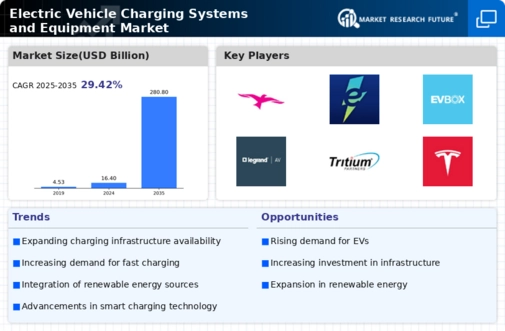Market Growth Projections
The Global Electric Vehicle Charging Systems and Equipment Market Industry is poised for substantial growth, with projections indicating a market value of 16.4 USD Billion in 2024 and an anticipated increase to 280.8 USD Billion by 2035. This growth trajectory reflects a compound annual growth rate of 29.42% from 2025 to 2035, driven by factors such as rising electric vehicle adoption, government initiatives, and technological advancements. The market's expansion is indicative of a broader shift towards sustainable transportation solutions, highlighting the increasing importance of charging infrastructure in supporting the transition to electric mobility.
Consumer Awareness and Education
Consumer awareness and education regarding electric vehicles and charging systems are crucial for the Global Electric Vehicle Charging Systems and Equipment Market Industry. As consumers become more informed about the benefits of electric vehicles, including lower operating costs and environmental advantages, their willingness to adopt this technology increases. Educational campaigns and outreach initiatives by manufacturers and governments are essential in dispelling myths and providing accurate information about electric vehicle charging. This heightened awareness is likely to drive demand for charging solutions, ultimately contributing to the market's growth trajectory as more consumers transition to electric mobility.
Rising Demand for Electric Vehicles
The increasing adoption of electric vehicles is a primary driver for the Global Electric Vehicle Charging Systems and Equipment Market Industry. As consumers become more environmentally conscious, the demand for electric vehicles is projected to surge, leading to a market value of 16.4 USD Billion in 2024. This trend is further supported by government incentives and regulations aimed at reducing carbon emissions. Consequently, the need for robust charging infrastructure is paramount, as it facilitates the transition to electric mobility. The expansion of charging networks is essential to meet the anticipated growth in electric vehicle sales, which is expected to reach unprecedented levels in the coming years.
Expansion of Charging Infrastructure
The expansion of charging infrastructure is a vital driver for the Global Electric Vehicle Charging Systems and Equipment Market Industry. As electric vehicle ownership rises, the need for accessible and reliable charging stations becomes increasingly important. Investments in public and private charging networks are essential to alleviate range anxiety among potential electric vehicle buyers. This expansion is supported by partnerships between governments and private companies, which aim to create a comprehensive charging ecosystem. The growth of charging infrastructure is expected to contribute significantly to the market's projected compound annual growth rate of 29.42% from 2025 to 2035, reflecting the increasing reliance on electric mobility.
Government Initiatives and Regulations
Government policies and regulations play a crucial role in shaping the Global Electric Vehicle Charging Systems and Equipment Market Industry. Many countries are implementing stringent emissions standards and offering financial incentives for electric vehicle adoption. For instance, various governments are investing in charging infrastructure to support their climate goals. These initiatives not only encourage consumers to switch to electric vehicles but also stimulate the growth of charging equipment manufacturers. As a result, the market is likely to experience substantial growth, with projections indicating a market size of 280.8 USD Billion by 2035, driven by supportive regulatory frameworks.
Technological Advancements in Charging Solutions
Technological innovations in charging solutions are significantly influencing the Global Electric Vehicle Charging Systems and Equipment Market Industry. Developments such as fast charging technologies and smart charging systems enhance the efficiency and convenience of electric vehicle charging. These advancements are likely to attract more consumers to electric vehicles, thereby increasing the demand for charging infrastructure. The integration of renewable energy sources into charging stations also aligns with sustainability goals, further promoting electric vehicle adoption. As the market evolves, these technological enhancements are expected to play a pivotal role in shaping consumer preferences and driving market growth.























